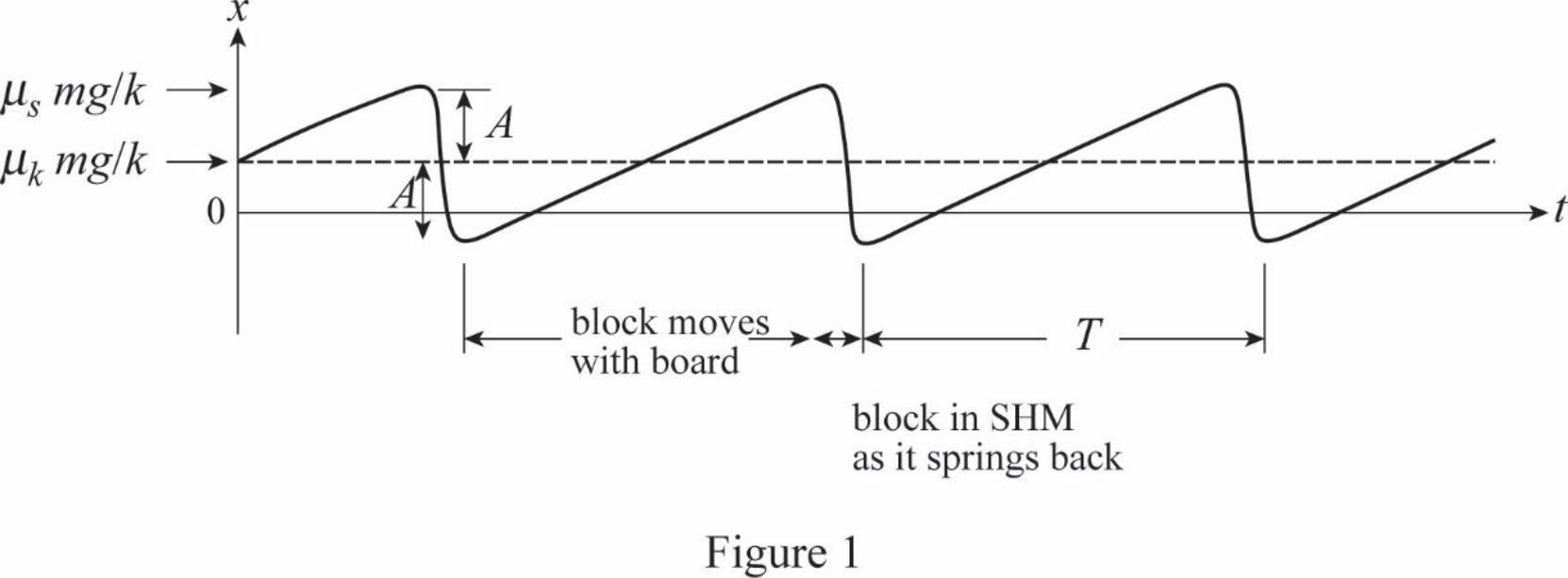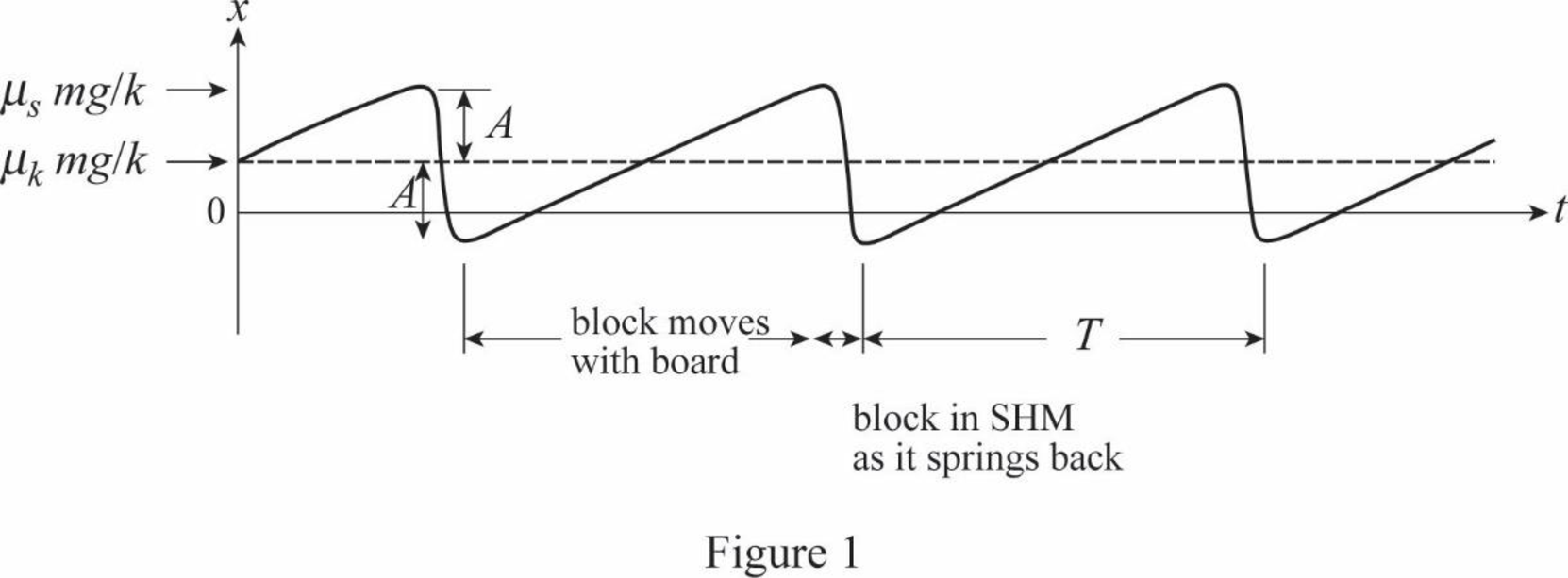
Concept explainers
(a)
Prove that the maximum stretching of spring from mean position is
(a)
Answer to Problem 60P
It is proved that the maximum stretching of spring from mean position is
Explanation of Solution
Write the relation between force on spring and maximum static frictional force.
Here,
Write the expression for
Here,
Rewrite the first equation by substituting the above one.
Conclusion:
Rewrite the expression for
Therefore, it is proved that the maximum stretching of spring from mean position is
(b)
Prove that block oscillates about mean point when spring is stretched by
(b)
Answer to Problem 60P
It is proved that block oscillates about mean point when spring is stretched by
Explanation of Solution
The block will be almost at rest at the break point because of the smaller value of velocity. The block starts to oscillate s soon when the force on block becomes
Here,
Rewrite the above equation by multiplying and dividing the second term with
Express the term
Here,
Rewrite the expression for
Conclusion:
From the above calculation, it is evident that block starts to be in simple harmonic motion about mean position on displacing the spring
Therefore, it is proved that block oscillates about mean point when spring is stretched by
(c)
Plot the variation of position of block with time.
(c)
Answer to Problem 60P
The plot is

Explanation of Solution
The graph is plotted with time on x-axis and position on y-axis.

The dotted line along x-axis denotes the function
Conclusion:
Therefore, the graph is plotted
(d)
Prove that the amplitude of oscillation is
(d)
Answer to Problem 60P
It is proved that the amplitude of oscillation is
Explanation of Solution
Write the expression for
Rewrite the above expression by substituting
Amplitude is the maximum displacement from the mean position only. Rewrite the expression as amplitude.
Here,
On pulling the block to distance
Conclusion:
Therefore, it is proved that the amplitude of oscillation is
(e)
Prove that the period of oscillation is
(e)
Answer to Problem 60P
It is proved that the period of oscillation is
Explanation of Solution
Write the expression for time taken by block to move with the board
Here,
Rewrite the expression by substituting
Time taken by block to move from mean position to an extreme position.
Here,
The period of oscillation is the sum of
Here,
Conclusion:
Rewrite the above equation by substituting the relations for
Therefore, It is proved that the period of oscillation is
Want to see more full solutions like this?
Chapter 12 Solutions
Principles of Physics: A Calculus-Based Text
- A 500-kg object attached to a spring with a force constant of 8.00 N/m vibrates in simple harmonic motion with an amplitude of 10.0 cm. Calculate the maximum value of its (a) speed and (b) acceleration, (c) the speed and (d) the acceleration when the object is 6.00 cm from the equilibrium position, and (e) the time interval required for the object to move from x = 0 to x = 8.00 cm.arrow_forwardIn an engine, a piston oscillates with simple harmonic motion so that its position varies according to the expression x=5.00cos(2t+6) where x is in centimeters and t is in seconds. At t = 0, find (a) the position of the piston, (b) its velocity, and (c) its acceleration. Find (d) the period and (e) the amplitude of the motion.arrow_forwardA small object is attached to the end of a string to form a simple pendulum. The period of its harmonic motion is measured for small angular displacements and three lengths. For lengths of 1.000 m, 0.750 m, and 0.500 m, total time intervals for 50 oscillations of 99.8 s, 86.6 s, and 71.1s are measured with a stopwatch. (a) Determine the period of motion for each length. (b) Determine the mean value of g obtained from these three independent measurements and compare it with the accepted value. (c) Plot T2 versus L and obtain a value for g from the slope of your best-fit straight-line graph. (d) Compare the value found in part (c) with that obtained in part (b).arrow_forward
- Four people, each with a mass of 72.4 kg, are in a car with a mass of 1 130 kg. An earthquake strikes. The vertical oscillations of the ground surface make the car bounce up and down on its suspension springs, but the driver manages to pull off the road and stop. When the frequency of the shaking is 1.80 Hz, the car exhibits a maximum amplitude of vibration. The earthquake ends and the four people leave the car as fast as they can. By what distance does the cars undamaged suspension lift the cars body as the people get out?arrow_forwardA car of mass 2.00 103 kg is lowered by 1.50 cm when four passengers, each of mass 70.0 kg, sit down in it. a. Determine the damping constant b of the shock absorbers that will provide critical damping. b. Suppose for the same car the shock absorbers are so worn that they provide almost no damping. Find the period of up-and-down oscillation of the car after hitting a bump in the road.arrow_forwardAn automobile with a mass of 1000 kg, including passengers, settles 1.0 cm closer to the road for every additional 100 kg of passengers. It is driven with a constant horizontal component of speed 20 km/h over a washboard road with sinusoidal bumps. The amplitude and wavelength of the sine curve are 5.0 cm and 20 cm, respectively. The distance between the front and back wheels is 2.4 m. Find the amplitude of oscillation of the automobile, assuming it moves vertically as an undamped driven harmonic oscillator. Neglect the mass of the wheels and springs and assume that the wheels are always in contact with the road.arrow_forward
- An object of mass m moves in simple harmonic motion with amplitude 12.0 cm on a light spring. Its maximum acceleration is 108 cm/s2. Regard m as a variable. (a) Find the period T of the object. (b) Find its frequency f. (c) Find the maximum speed vmax of the object. (d) Find the total energy E of the objectspring system. (e) Find the force constant k of the spring. (f) Describe the pattern of dependence of each of the quantities T, f, vmax, E, and k on m.arrow_forwardWhich of the following statements is not true regarding a massspring system that moves with simple harmonic motion in the absence of friction? (a) The total energy of the system remains constant. (b) The energy of the system is continually transformed between kinetic and potential energy. (c) The total energy of the system is proportional to the square of the amplitude. (d) The potential energy stored in the system is greatest when the mass passes through the equilibrium position. (e) The velocity of the oscillating mass has its maximum value when the mass passes through the equilibrium position.arrow_forwardA block of mass m is connected to two springs of force constants k1 and k2 in two ways as shown in Figure P12.56. In both cases, the block moves on a frictionless table after it is displaced from equilibrium and released. Show that in the two cases the block exhibits simple harmonic motion with periods (a) T=2m(k1+k2)k1k2 and (b) T=2mk1+k2 Figure P12.56arrow_forward
- A block of unknown mass is attached to a spring with a spring constant of 6.50 N/m and undergoes simple harmonic motion with an amplitude of 10.0 cm. When the block is halfway between its equilibrium position and the end point, its speed is measured to be 30.0 cm/s. Calculate (a) the mass of the block, (b) the period of the motion, and (c) the maximum acceleration of the block.arrow_forwardIf the amplitude of a damped oscillator decreases to 1/e of its initial value after n periods, show that the frequency of the oscillator must be approximately [1 − (8π2n2)−1] times the frequency of the corresponding undamped oscillator.arrow_forwardA blockspring system oscillates with an amplitude of 3.50 cm. The spring constant is 250 N/m and the mass of the block is 0.500 kg. Determine (a) the mechanical energy of the system, (b) the maximum speed of the block, and (c) the maximum acceleration.arrow_forward
 Principles of Physics: A Calculus-Based TextPhysicsISBN:9781133104261Author:Raymond A. Serway, John W. JewettPublisher:Cengage Learning
Principles of Physics: A Calculus-Based TextPhysicsISBN:9781133104261Author:Raymond A. Serway, John W. JewettPublisher:Cengage Learning Physics for Scientists and Engineers with Modern ...PhysicsISBN:9781337553292Author:Raymond A. Serway, John W. JewettPublisher:Cengage Learning
Physics for Scientists and Engineers with Modern ...PhysicsISBN:9781337553292Author:Raymond A. Serway, John W. JewettPublisher:Cengage Learning Physics for Scientists and EngineersPhysicsISBN:9781337553278Author:Raymond A. Serway, John W. JewettPublisher:Cengage Learning
Physics for Scientists and EngineersPhysicsISBN:9781337553278Author:Raymond A. Serway, John W. JewettPublisher:Cengage Learning Classical Dynamics of Particles and SystemsPhysicsISBN:9780534408961Author:Stephen T. Thornton, Jerry B. MarionPublisher:Cengage Learning
Classical Dynamics of Particles and SystemsPhysicsISBN:9780534408961Author:Stephen T. Thornton, Jerry B. MarionPublisher:Cengage Learning College PhysicsPhysicsISBN:9781305952300Author:Raymond A. Serway, Chris VuillePublisher:Cengage Learning
College PhysicsPhysicsISBN:9781305952300Author:Raymond A. Serway, Chris VuillePublisher:Cengage Learning College PhysicsPhysicsISBN:9781285737027Author:Raymond A. Serway, Chris VuillePublisher:Cengage Learning
College PhysicsPhysicsISBN:9781285737027Author:Raymond A. Serway, Chris VuillePublisher:Cengage Learning





